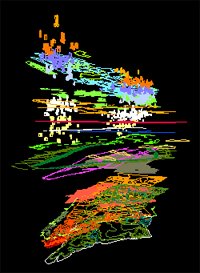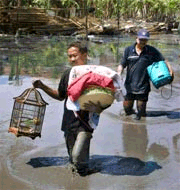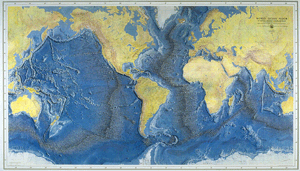Science Blogs
Blogs, magazines, and articles, mostly science and research related.
473 listings
|
Submitted Sep 08, 2006 to Science Blogs » Element FYI  NASA Shuttle Launch TODAY! - As of this writing at 7:00am EST, we are only four and a half hours away from the launch of the Space Shuttle Atlantis from NASA's Kennedy Space Center in Florida. NASA, getting all techy on us, actually has its own Mission STS-115 launch blog and live webTV feed for the event. Don't miss it. [UPDATE: Liftoff has been delayed 24 hours so that we can gaze upon the technological wonder on the launching pad just a little longer.] NASA Shuttle Launch TODAY! - As of this writing at 7:00am EST, we are only four and a half hours away from the launch of the Space Shuttle Atlantis from NASA's Kennedy Space Center in Florida. NASA, getting all techy on us, actually has its own Mission STS-115 launch blog and live webTV feed for the event. Don't miss it. [UPDATE: Liftoff has been delayed 24 hours so that we can gaze upon the technological wonder on the launching pad just a little longer.] |
|
Submitted Sep 08, 2006 to Science Blogs The shortest distance between you and science. A project of NYU's Science, Health, and Environmental Reporting Program.
|
|
Submitted Sep 08, 2006 to Science Blogs I am currently pursuing a master's in science & environmental reporting at New York University and have just accepted a permanent position at Seed Magazine. I received my B.S. in cell & molecular biology from the University of Michigan.
|
|
Submitted Sep 08, 2006 to Science Blogs Breaking, under-reported, and fascinating news in microbiology and infectious disease. I am a radio producer and reporter, freelancer, and working scientist.
|
|
Submitted Sep 08, 2006 to Science Blogs John Rogers started doing stand-up in 1988, got his Physics degree in 1990, began writing television in 1995, writing movies in 1999, and writing comics in 2005. He plainly needs to focus.
|
|
Submitted Sep 07, 2006 to Science Blogs Welcome to the FairerScience.org blog. This is not the data and research based part of the website. We use the blog to bring up and comment on funny and not so funny news and information directly (or even indirectly) related to FairerScience.
|
|
Submitted Sep 07, 2006 to Science Blogs » Element FYI  FairerScience has two good articles on how to present your scientific research to journalists in a way that will help them convey the main points to readers. In KISI (Keep It Simple and Interesting): Journalists' Advice to Researchers, FairerScience recommends that you simplify your story for the journalist, or risk having the journalist simplify it for you, possibly leaving out important points and caveats. Also, have a few good jargon-free quotes or soundbites prepared, since the journalist will only publish your direct quotes, not quotes from your article. Don't forget, any good journalist will cross-check your work with other scientists in your field. You can help them and yourself out by having names and contact information for the experts in your field. In KICI (Keep It Careful and Intelligent): Researchers' Advice About Journalists, FairerScience offers tips on how to be your own best public relations rep by being careful about what you say to journalists and avoiding 'gotcha' moments that could lead to public embarrassment or worse. KICI's first bit of advice is that you know the journalist's perspective on the subject before you agree to do an interview. Also, have your main points prepared in advance and don't be afraid to use them in multiple interviews. Keeping a consistent message will help you get your important points across to the audience. FairerScience has two good articles on how to present your scientific research to journalists in a way that will help them convey the main points to readers. In KISI (Keep It Simple and Interesting): Journalists' Advice to Researchers, FairerScience recommends that you simplify your story for the journalist, or risk having the journalist simplify it for you, possibly leaving out important points and caveats. Also, have a few good jargon-free quotes or soundbites prepared, since the journalist will only publish your direct quotes, not quotes from your article. Don't forget, any good journalist will cross-check your work with other scientists in your field. You can help them and yourself out by having names and contact information for the experts in your field. In KICI (Keep It Careful and Intelligent): Researchers' Advice About Journalists, FairerScience offers tips on how to be your own best public relations rep by being careful about what you say to journalists and avoiding 'gotcha' moments that could lead to public embarrassment or worse. KICI's first bit of advice is that you know the journalist's perspective on the subject before you agree to do an interview. Also, have your main points prepared in advance and don't be afraid to use them in multiple interviews. Keeping a consistent message will help you get your important points across to the audience. |
|
Submitted Sep 06, 2006 to Science Blogs With a nod to a popular animated television series beloved by many, and perhaps reviled by some, I assumed the pseudonym of a scientist who sports a sensible ponytail, dines on grubs, and who exploits chimpanzees in her illegal diamond mine. To paraphrase Homer Simpson's reply to Dr. Bushwell after she describes her daily routine (Simpson Safari; season 12, episode 265), I must be the most boring woman on earth. Nonetheless, I am compelled to slap my mundane, yet occasionally piquant, thoughts up on the walls of this blog. In the process, I have gathered a team of bright, engaging, and cheeky primates who share my passion for science and its impact on our culture. We hope to offer the reader a bed of diamonds in the rough upon which to roll: "Oooooh, look! I'm a scientist!"
|
|
Submitted Sep 06, 2006 to Science Blogs Zuska is the kick-ass alter-ego of Suzanne E Franks. When not dispensing Zuska's wisdom, Suzanne can often be found gardening, reading, or having one of her thrice-weekly migraines. Covers feminism and women in science.
|
|
Submitted Sep 06, 2006 to Science Blogs » Element FYI  Own your very own piece of science history with the Element List 2005 Year of Physics Commemorative T-Shirt. It's 2006, you say? So what! It's not old, it's vintage! If last year's 2005YoP t-shirt is looking a little tattered from too many keggers in the lab, now is your chance to buy a fresh, spanking new one. The unique Element List design features Einstein iPodified against a bright blue blackground with the Element List URL printed on the back. The t-shirt is 100% cotton and comes in body hugging cuts for men and women. We have mugs, bags, and mousepads, too. Hurry up and buy yours before this design is gone forever! Own your very own piece of science history with the Element List 2005 Year of Physics Commemorative T-Shirt. It's 2006, you say? So what! It's not old, it's vintage! If last year's 2005YoP t-shirt is looking a little tattered from too many keggers in the lab, now is your chance to buy a fresh, spanking new one. The unique Element List design features Einstein iPodified against a bright blue blackground with the Element List URL printed on the back. The t-shirt is 100% cotton and comes in body hugging cuts for men and women. We have mugs, bags, and mousepads, too. Hurry up and buy yours before this design is gone forever! |
|
Submitted Sep 06, 2006 to Science Blogs nth position is a free online magazine/ezine with politics & opinion, travel writing, fiction & poetry, reviews & interviews, and some high weirdness.
|
|
Submitted Sep 05, 2006 to Science Blogs » Element FYI  It's an understatement to say that Manhattan looks nothing like the quaint little island it was when the first Dutch settlers arrived. Not only has most of Manhattan been covered in concrete, but the near-surface geology has been altered over the past 370 years with a maze of tunnels. To map these changes over time, architect Brian McGrath and designer Mark Watkins have created Manhattan Transformations, an interactive time-lapse three-dimensional computer model of man-made changes to the landscape of lower Manhattan. The multimedia exhibit is hosted by the Skyscraper Museum in Manhattan's Battery Park and can be viewed online. The model presents not only the architectural development of the city, but also a cartographic history of the underground infrastructure that delivers water, electricity, gas, telecommunications, and subway trains to lower Manhattan. As you click through the online exhibit, you can selectively display specific information such as office buildings built between 1917-1940, the location of the Dutch settlements, topography contours, and riverbank areas underlain by landfill. It's like looking at a CAT scan of the city. It's an understatement to say that Manhattan looks nothing like the quaint little island it was when the first Dutch settlers arrived. Not only has most of Manhattan been covered in concrete, but the near-surface geology has been altered over the past 370 years with a maze of tunnels. To map these changes over time, architect Brian McGrath and designer Mark Watkins have created Manhattan Transformations, an interactive time-lapse three-dimensional computer model of man-made changes to the landscape of lower Manhattan. The multimedia exhibit is hosted by the Skyscraper Museum in Manhattan's Battery Park and can be viewed online. The model presents not only the architectural development of the city, but also a cartographic history of the underground infrastructure that delivers water, electricity, gas, telecommunications, and subway trains to lower Manhattan. As you click through the online exhibit, you can selectively display specific information such as office buildings built between 1917-1940, the location of the Dutch settlements, topography contours, and riverbank areas underlain by landfill. It's like looking at a CAT scan of the city. |
|
Submitted Sep 05, 2006 to Science Blogs Evolution, culture, philosophy and chocolate! John Wilkins' continuing struggle to come to terms with impermanence...
|
|
Submitted Sep 05, 2006 to Science Blogs Scientifically Minded: Science news and discussion from neuroimaging, bioethics, autism, genetics, and elsewhere.
|
|
|
|
Submitted Sep 05, 2006 to Science Blogs How to learn for free on the web. In collaboration with textbookrevolution.org.
|
|
Submitted Sep 05, 2006 to Science Blogs » Element FYI  Tired of paying hundreds of dollars for science textbooks each semester? Jason Turgeon has come to the rescue with Textbook Revolution, a website containing links to free, online textbooks in a range of science topics from biology to computer science to math and physics. Even if you have already bought your textbooks for the semester, the site is useful for finding additional information and alternative perspectives on the same subjects. Some textbooks are not exactly books in the linear sense, but are websites with plentiful graphics and flash-based multimedia, such as An Outline of American Geography by Birdsall and Florin and Plate Tectonics by Kare Kullerud. If you have a textbook of your own to contribute, Textbook Revolution is always looking for more submissions. Tired of paying hundreds of dollars for science textbooks each semester? Jason Turgeon has come to the rescue with Textbook Revolution, a website containing links to free, online textbooks in a range of science topics from biology to computer science to math and physics. Even if you have already bought your textbooks for the semester, the site is useful for finding additional information and alternative perspectives on the same subjects. Some textbooks are not exactly books in the linear sense, but are websites with plentiful graphics and flash-based multimedia, such as An Outline of American Geography by Birdsall and Florin and Plate Tectonics by Kare Kullerud. If you have a textbook of your own to contribute, Textbook Revolution is always looking for more submissions. |
|
Submitted Sep 04, 2006 to Science Blogs » Element FYI
|
|
Submitted Sep 04, 2006 to Science Blogs » Element FYI  The latest edition of Nature reports that oil and gas exploration company PT Lapindo Brantas may have triggered the eruption of a mud volcano on the island of Java on May 28 during drilling. According to Nature, mud has been spewing from the ground for the last three months at a rate of 50,000 cubic meters per day. Abnormally high temperatures (60C) and hydrogen sulphide gas released with the mud suggests that the volcano is connected to a deep volcanic, hydrothermal source located nearly 3 kilometers below the surface. Geologists suspect that drilling penetrated an over-pressured volume of liquified sediment, which buoyantly pushed its way up to the surface. Walhi reports that gas initially "sprayed 10 meters high from cracks in the ground ... followed by hot mud." The flow of mud has displaced over 9,000 residents from their homes to date. East Java Police seized the rig that triggered the release of mud and gas. Offshore mud volcanos are common in the Java area, which overlies a subduction zone, where water and sediments are carried deep beneath the islands. "According to many geological experts, the scale of this mud volcano is unprecedented -- at least on land," writes Nature. The latest edition of Nature reports that oil and gas exploration company PT Lapindo Brantas may have triggered the eruption of a mud volcano on the island of Java on May 28 during drilling. According to Nature, mud has been spewing from the ground for the last three months at a rate of 50,000 cubic meters per day. Abnormally high temperatures (60C) and hydrogen sulphide gas released with the mud suggests that the volcano is connected to a deep volcanic, hydrothermal source located nearly 3 kilometers below the surface. Geologists suspect that drilling penetrated an over-pressured volume of liquified sediment, which buoyantly pushed its way up to the surface. Walhi reports that gas initially "sprayed 10 meters high from cracks in the ground ... followed by hot mud." The flow of mud has displaced over 9,000 residents from their homes to date. East Java Police seized the rig that triggered the release of mud and gas. Offshore mud volcanos are common in the Java area, which overlies a subduction zone, where water and sediments are carried deep beneath the islands. "According to many geological experts, the scale of this mud volcano is unprecedented -- at least on land," writes Nature. |
|
Submitted Aug 26, 2006 to Science Blogs » Element FYI  You may not know her name, but you've very likely seen one of her maps of the global ocean floor. Beginning in the 1940s, Marie Tharp worked at Lamont-Doherty Earth Observatory of Columbia University painstakingly plotting academic and U.S. Navy sonar readings onto basemaps to show the detailed bathymetry of the oceans. Her maps, created in collaboration with famous oceanographer Bruce Heezen, were the first to reveal the presence of the Mid-Atlantic Ridge rift valley, which was a crucial piece in the puzzle in the early days of the development of plate tectonic theory. Later, Marie and Bruce created the famous World Ocean Floor Map, published in 1977 (above), long before rapid computer digitzation or satellite imagery became available. Marie Tharp passed away this past Wednesday morning, August 23 in Nyack, NY due to complications with cancer. She was 86. You may not know her name, but you've very likely seen one of her maps of the global ocean floor. Beginning in the 1940s, Marie Tharp worked at Lamont-Doherty Earth Observatory of Columbia University painstakingly plotting academic and U.S. Navy sonar readings onto basemaps to show the detailed bathymetry of the oceans. Her maps, created in collaboration with famous oceanographer Bruce Heezen, were the first to reveal the presence of the Mid-Atlantic Ridge rift valley, which was a crucial piece in the puzzle in the early days of the development of plate tectonic theory. Later, Marie and Bruce created the famous World Ocean Floor Map, published in 1977 (above), long before rapid computer digitzation or satellite imagery became available. Marie Tharp passed away this past Wednesday morning, August 23 in Nyack, NY due to complications with cancer. She was 86. |



















